Post by Fernando Rivadavia on Jan 3, 2014 17:21:38 GMT
Hello everyone,
It is with great pleasure (and relief) that I would like to announce the publication of a 40-page paper that summarizes 23 years of field work with the Drosera villosa complex in Brazil. I think I wrote the first draft of this article back in 1997, but the writing only truly gained momentum starting in 2008 as I brought in my excellent co-authors, who not only made the whole thing look a lot prettier and more professional than my early versions, but also added numerous amazing insights. Not to mention a new species that popped up out of the blue a few years ago, as well as the amazing rediscovery (after nearly 200 years) of the true D.ascendens.
Yep, the bad news for everyone is that you will have to re-label what was previously known as D.ascendens to D.latifolia.
So in short, the Drosera villosa complex now includes six species: D.villosa, D.ascendens, D.graomogolensis, D.latifolia, D.riparia and D.chimaera.
Here's a link to a view of the abstract & conclusions:
www.mapress.com/phytotaxa/content/2014/f/p00156p040f.pdf
Here's a link to download the article:
biotaxa.org/Phytotaxa/article/view/phytotaxa.156.1.1
If you can't download it, just shoot me a message with your email address.
Here's a short summary of the 6 species.
Drosera villosa: The type D.villosa is a narrow endemic known from only two small mountain ranges in southern Minas Gerais state. Compared to other taxa in this complex, it has relatively long & narrow leaves, very hairy, and with petioles about as long as the lamina.
D.villosa at the Serra de Ibitipoca, Minas Gerais (sorry for bad quality, these are old scanned pics):

D.villosa & D.tomentosa var.glabrata growing on sandstone at the Serra de Ibitipoca:

D.villosa at the Serra Negra, Minas Gerais (type location, pics by Nilber Silva):
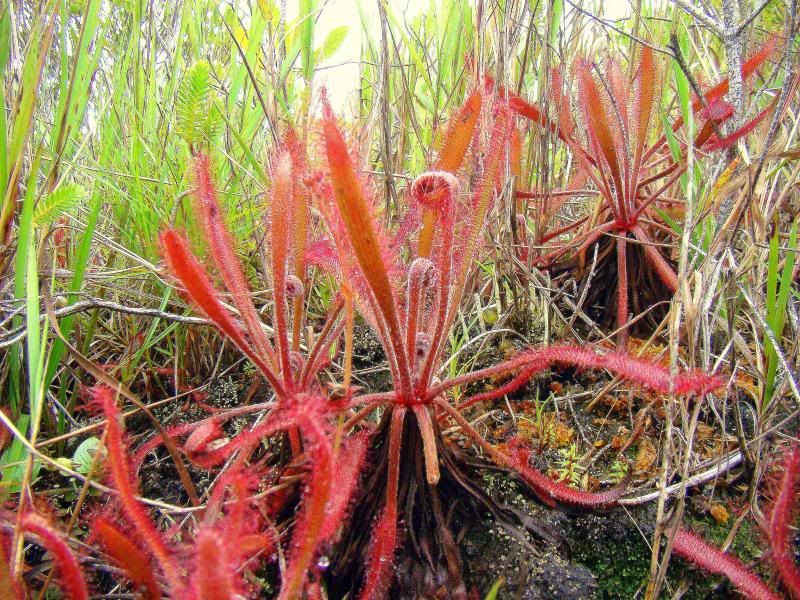


For pics of the natural hybrid D.villosa X D.tomentosa var.glabrata at the Serra de Ibitipoca, check out this link:http://www.cpphotofinder.com/drosera-x-villosa-x-tomentosa-4778.html
Drosera ascendens: The type D.ascendens is also a narrow endemic known only from a small area on the northern end of the Diamantina Plateau, in central Minas Gerais. It was originally collected by Saint-Hilaire in the early 1800's and was only rediscovered a few years ago by our great friend and explorer Adilson Peres near the small town of Inhaí (and thus referred to as D.sp."Inhaí" since then). Other than the odd ascending flower scape, this species is unique among New World Drosera in having the flower scapes densely covered with huge red glandular hairs.
D.ascendens near Inhaí, Minas Gerais:

D.ascendens at the Parque Nacional das Sempre Vivas, Minas Gerais:
 ]
]

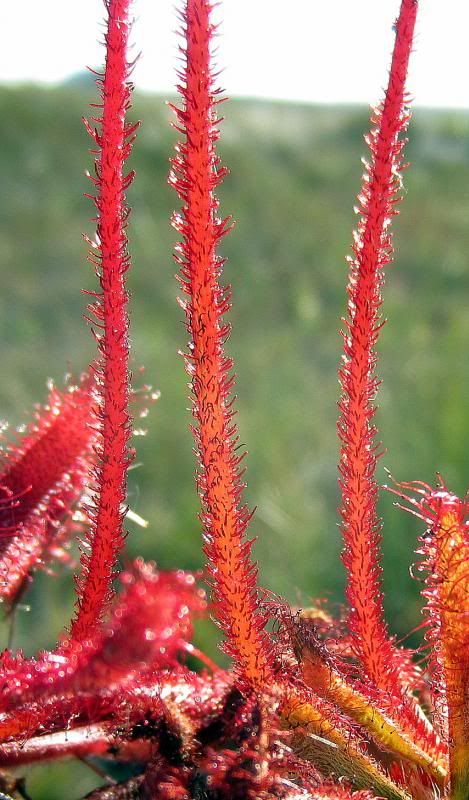
Drosera graomogolensis: No worries, there are no changes to this species! We simply recognized that it is more widespread than previously recorded, occurring throughout the Serra do Grão Mogol area in northern Minas Gerais. Among other characters, it is distinguished by its shorter leaves (especially petioles), stem-forming habit, and large flowers with long styles (shared with D.ascendens, to which it is most closely related).
We simply recognized that it is more widespread than previously recorded, occurring throughout the Serra do Grão Mogol area in northern Minas Gerais. Among other characters, it is distinguished by its shorter leaves (especially petioles), stem-forming habit, and large flowers with long styles (shared with D.ascendens, to which it is most closely related).
D.graomogolensis growing by a river near Botumirim, Minas Gerais:


D.graomogolensis growing in drier habitat near Botumirim:
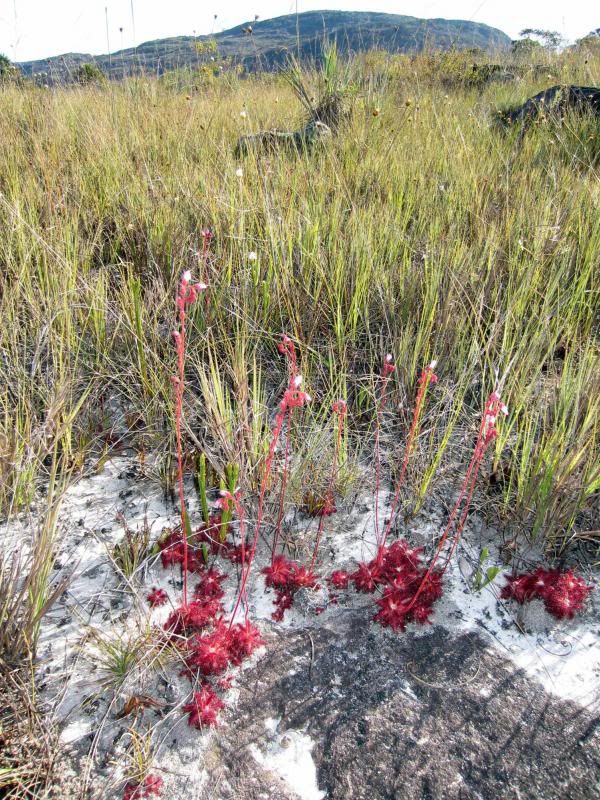
Columns of dead leaves are common for D.graomogolensis (growing near Botumirim):

D.graomogolensis (right) and D.spiralis (left) near Botumirim:

D.graomogolensis near Grão Mogol, Minas Gerais:

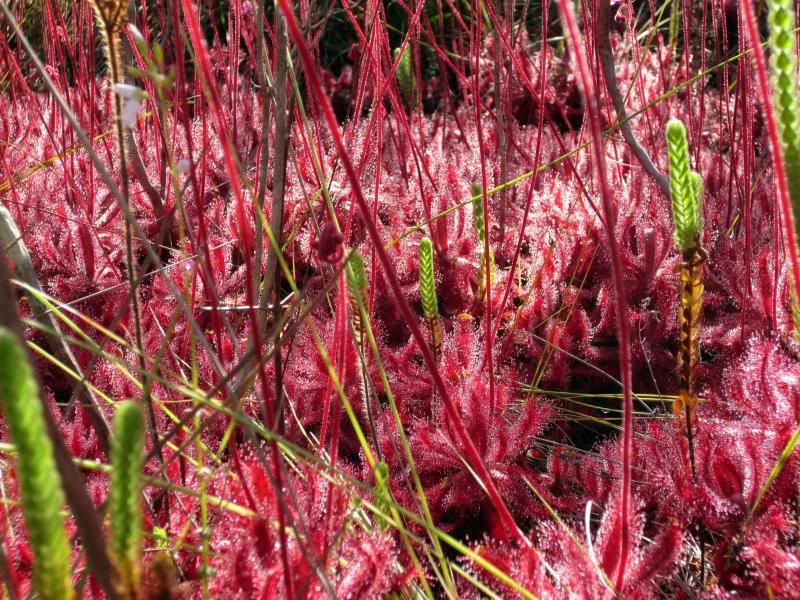
Drosera latifolia: OK, this is where it gets complicated... For the past ~20 years I'd been pushing CPers to call this plant "D.ascendens", to distinguish it from the very different type D.villosa. Unfortunately, as mentioned above, the true D.ascendens turned out to be something entirely different, hidden to us for nearly 200 years. So we had to resuscitate the oldest known name for this taxon, D.villosa var.latifolia, upgrading it to species level. This taxon is by far the most widespread in this complex, occurring from southern to central Brazil, and thus not surprisingly also the most variable. For years we struggled with what all this variability represented: ecological variation, varieties, subspecies, hybrids, or just high morphological variability within a single taxon? Because so much more field work (as well as DNA analyses) would still be necessary to answer this question, in the end we decided to describe the geographic forms as "morphotypes", so that we could publish this article before we were all old senile men.
Anyway, 6 morphotypes are recognized: Typical morphotype, Serra do Mar morphotype, Salesópolis morphotype, Serra do Espinhaço morphotype, Pico do Itambé morphotype, and Serra do Caparaó morphotype.
D.latifolia “type morphotype” at the Serra dos Órgãos (type location), Rio de Janeiro:

D.latifolia “type morphotype” at Pico da Caledônia, Rio de Janeiro:


D.latifolia “type morphotype” at Itatiaia National Park, Minas Gerais/ Rio de Janeiro border:

D.latifolia “type morphotype” with U.reniformis at Itatiaia National Park, Minas Gerais/ Rio de Janeiro border:

D.latifolia “Serra do Mar morphotype” and D.communis near Paranapiacaca, São Paulo:

D.latifolia “Serra do Mar morphotype” at Caminho do Mar, São Paulo:

D.latifolia “Serra do Mar morphotype” near Parelheiros, São Paulo:

D.latifolia “Salesópolis morphotype” near Salesópolis, São Paulo:


D.latifolia “Serra do Caparaó morphotype” on the Pico da Bandeira, Minas Gerais/ Espírito Santo border (old scanned pics, sorry for bad quality!):


D.latifolia “Pico do Itambé morphotype” on the Pico do Itambé, Minas Gerais (old scanned pics, sorry for bad quality!):



D.latifolia “Serra do Espinhaço morphotype” at the Parque Nacional das Sempre Vivas, Minas Gerais:


D.latifolia “Serra do Espinhaço morphotype” with aquatic G.repens at the Parque Nacional das Sempre Vivas, Minas Gerais:

D.latifolia “Serra do Espinhaço morphotype” near Couto de Magalhães, Minas Gerais:

D.latifolia “Serra do Espinhaço morphotype” (top) and its hybrid with D.tomentosa var.tomentosa (bottom) near Couto de Magalhães, Minas Gerais:

D.latifolia “Serra do Espinhaço morphotype” (green plants on left) and its hybrid with D.tomentosa var.glabrata (red plant on right) near Diamantina, Minas Gerais:

D.latifolia “Serra do Espinhaço morphotype” X D.tomentosa var.glabrata near Diamantina, Minas Gerais (old scanned pic, sorry for bad quality!):
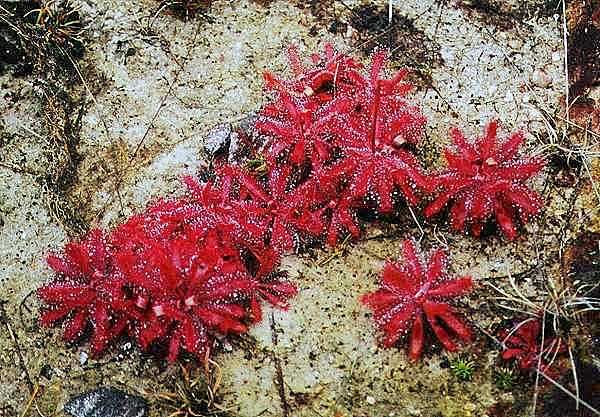
Drosera riparia: This species is endemic to highlands of Bahia in NE Brazil. I originally discovered it back in 1992/3 and it is somewhat common in cultivation, known as D.sp."Bahia". It is the smallest of the taxa in the villosa complex and has even been mistaken by one (crazy!) taxonomist as D.communis - possibly because of its smaller size and long petioles. The name "riparia" referes to the common habitat where this species was observed: growing along river and stream margins.
D.riparia at Catolés, Bahia (old scanned slides, sorry for bad quality):


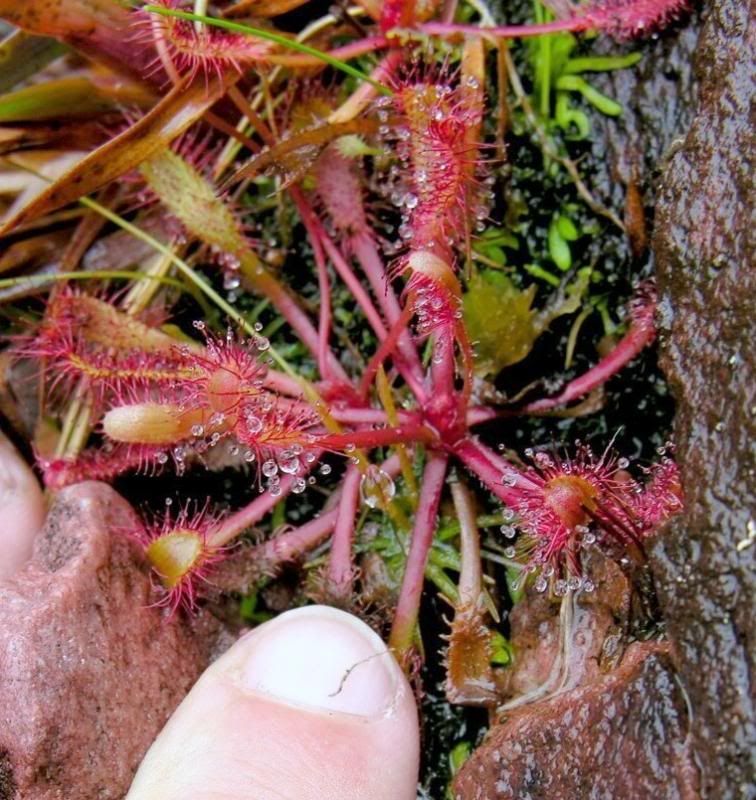
D.riparia at the Serra das Sete Voltas, Bahia:



A small D.riparia (bottom), D.tomentosa (center), and D.communis (top) at the Pico das Almas, Bahia:

Drosera chimaera: This species was also recently discovered by our friend Adilson Peres and is a narrow endemic of the Serra de Grão Mogol, currently know only from 3 populations. We were really confused by this one initially, just from looking at the pics, and we ended up having to go see it personally in its natural habitat in order to convince ourselves that it was a good species. In cultivation it has been called D.sp."hairy ascendens". The name "chimaera" was given because this species is a mosaic of characters, with rosettes that resemble a small D.latifolia, but inflorescences and seed that resemble those of D.tomentosa. However, D.latifolia is not know from that region, nor was D.chimaera observed growing near D.tomentosa or D.graomogolensis (both relatively common in the Grão Mogol area). Furthermore, it is highly fertile, producing tons of seed, suggesting that at best it is a species of hybridogenic origin. Or it could simply be the missing link between the D.villosa and D.montana complexes (BTW, we will have another paper out soon for the latter, including D.montana, D.tomentosa var.tomentosa, D.tomentosa var.glabrata, D.tentaculata, and a new species which has sometimes been referred to over the years as D.sp."Shibata").
D.chimaera at the type location between Grão Mogol and Cristália, Minas Gerais:


I hope you enjoy our publication, and please start changing your plant labels!
Happy 2014,
Fernando Rivadavia
It is with great pleasure (and relief) that I would like to announce the publication of a 40-page paper that summarizes 23 years of field work with the Drosera villosa complex in Brazil. I think I wrote the first draft of this article back in 1997, but the writing only truly gained momentum starting in 2008 as I brought in my excellent co-authors, who not only made the whole thing look a lot prettier and more professional than my early versions, but also added numerous amazing insights. Not to mention a new species that popped up out of the blue a few years ago, as well as the amazing rediscovery (after nearly 200 years) of the true D.ascendens.
Yep, the bad news for everyone is that you will have to re-label what was previously known as D.ascendens to D.latifolia.
So in short, the Drosera villosa complex now includes six species: D.villosa, D.ascendens, D.graomogolensis, D.latifolia, D.riparia and D.chimaera.
Here's a link to a view of the abstract & conclusions:
www.mapress.com/phytotaxa/content/2014/f/p00156p040f.pdf
Here's a link to download the article:
biotaxa.org/Phytotaxa/article/view/phytotaxa.156.1.1
If you can't download it, just shoot me a message with your email address.
Here's a short summary of the 6 species.
Drosera villosa: The type D.villosa is a narrow endemic known from only two small mountain ranges in southern Minas Gerais state. Compared to other taxa in this complex, it has relatively long & narrow leaves, very hairy, and with petioles about as long as the lamina.
D.villosa at the Serra de Ibitipoca, Minas Gerais (sorry for bad quality, these are old scanned pics):


D.villosa & D.tomentosa var.glabrata growing on sandstone at the Serra de Ibitipoca:

D.villosa at the Serra Negra, Minas Gerais (type location, pics by Nilber Silva):



For pics of the natural hybrid D.villosa X D.tomentosa var.glabrata at the Serra de Ibitipoca, check out this link:http://www.cpphotofinder.com/drosera-x-villosa-x-tomentosa-4778.html
Drosera ascendens: The type D.ascendens is also a narrow endemic known only from a small area on the northern end of the Diamantina Plateau, in central Minas Gerais. It was originally collected by Saint-Hilaire in the early 1800's and was only rediscovered a few years ago by our great friend and explorer Adilson Peres near the small town of Inhaí (and thus referred to as D.sp."Inhaí" since then). Other than the odd ascending flower scape, this species is unique among New World Drosera in having the flower scapes densely covered with huge red glandular hairs.
D.ascendens near Inhaí, Minas Gerais:

D.ascendens at the Parque Nacional das Sempre Vivas, Minas Gerais:
 ]
]

Drosera graomogolensis: No worries, there are no changes to this species!
 We simply recognized that it is more widespread than previously recorded, occurring throughout the Serra do Grão Mogol area in northern Minas Gerais. Among other characters, it is distinguished by its shorter leaves (especially petioles), stem-forming habit, and large flowers with long styles (shared with D.ascendens, to which it is most closely related).
We simply recognized that it is more widespread than previously recorded, occurring throughout the Serra do Grão Mogol area in northern Minas Gerais. Among other characters, it is distinguished by its shorter leaves (especially petioles), stem-forming habit, and large flowers with long styles (shared with D.ascendens, to which it is most closely related).D.graomogolensis growing by a river near Botumirim, Minas Gerais:


D.graomogolensis growing in drier habitat near Botumirim:

Columns of dead leaves are common for D.graomogolensis (growing near Botumirim):

D.graomogolensis (right) and D.spiralis (left) near Botumirim:

D.graomogolensis near Grão Mogol, Minas Gerais:


Drosera latifolia: OK, this is where it gets complicated... For the past ~20 years I'd been pushing CPers to call this plant "D.ascendens", to distinguish it from the very different type D.villosa. Unfortunately, as mentioned above, the true D.ascendens turned out to be something entirely different, hidden to us for nearly 200 years. So we had to resuscitate the oldest known name for this taxon, D.villosa var.latifolia, upgrading it to species level. This taxon is by far the most widespread in this complex, occurring from southern to central Brazil, and thus not surprisingly also the most variable. For years we struggled with what all this variability represented: ecological variation, varieties, subspecies, hybrids, or just high morphological variability within a single taxon? Because so much more field work (as well as DNA analyses) would still be necessary to answer this question, in the end we decided to describe the geographic forms as "morphotypes", so that we could publish this article before we were all old senile men.
Anyway, 6 morphotypes are recognized: Typical morphotype, Serra do Mar morphotype, Salesópolis morphotype, Serra do Espinhaço morphotype, Pico do Itambé morphotype, and Serra do Caparaó morphotype.
D.latifolia “type morphotype” at the Serra dos Órgãos (type location), Rio de Janeiro:

D.latifolia “type morphotype” at Pico da Caledônia, Rio de Janeiro:


D.latifolia “type morphotype” at Itatiaia National Park, Minas Gerais/ Rio de Janeiro border:

D.latifolia “type morphotype” with U.reniformis at Itatiaia National Park, Minas Gerais/ Rio de Janeiro border:

D.latifolia “Serra do Mar morphotype” and D.communis near Paranapiacaca, São Paulo:

D.latifolia “Serra do Mar morphotype” at Caminho do Mar, São Paulo:

D.latifolia “Serra do Mar morphotype” near Parelheiros, São Paulo:

D.latifolia “Salesópolis morphotype” near Salesópolis, São Paulo:


D.latifolia “Serra do Caparaó morphotype” on the Pico da Bandeira, Minas Gerais/ Espírito Santo border (old scanned pics, sorry for bad quality!):


D.latifolia “Pico do Itambé morphotype” on the Pico do Itambé, Minas Gerais (old scanned pics, sorry for bad quality!):



D.latifolia “Serra do Espinhaço morphotype” at the Parque Nacional das Sempre Vivas, Minas Gerais:


D.latifolia “Serra do Espinhaço morphotype” with aquatic G.repens at the Parque Nacional das Sempre Vivas, Minas Gerais:

D.latifolia “Serra do Espinhaço morphotype” near Couto de Magalhães, Minas Gerais:

D.latifolia “Serra do Espinhaço morphotype” (top) and its hybrid with D.tomentosa var.tomentosa (bottom) near Couto de Magalhães, Minas Gerais:

D.latifolia “Serra do Espinhaço morphotype” (green plants on left) and its hybrid with D.tomentosa var.glabrata (red plant on right) near Diamantina, Minas Gerais:

D.latifolia “Serra do Espinhaço morphotype” X D.tomentosa var.glabrata near Diamantina, Minas Gerais (old scanned pic, sorry for bad quality!):

Drosera riparia: This species is endemic to highlands of Bahia in NE Brazil. I originally discovered it back in 1992/3 and it is somewhat common in cultivation, known as D.sp."Bahia". It is the smallest of the taxa in the villosa complex and has even been mistaken by one (crazy!) taxonomist as D.communis - possibly because of its smaller size and long petioles. The name "riparia" referes to the common habitat where this species was observed: growing along river and stream margins.
D.riparia at Catolés, Bahia (old scanned slides, sorry for bad quality):



D.riparia at the Serra das Sete Voltas, Bahia:



A small D.riparia (bottom), D.tomentosa (center), and D.communis (top) at the Pico das Almas, Bahia:

Drosera chimaera: This species was also recently discovered by our friend Adilson Peres and is a narrow endemic of the Serra de Grão Mogol, currently know only from 3 populations. We were really confused by this one initially, just from looking at the pics, and we ended up having to go see it personally in its natural habitat in order to convince ourselves that it was a good species. In cultivation it has been called D.sp."hairy ascendens". The name "chimaera" was given because this species is a mosaic of characters, with rosettes that resemble a small D.latifolia, but inflorescences and seed that resemble those of D.tomentosa. However, D.latifolia is not know from that region, nor was D.chimaera observed growing near D.tomentosa or D.graomogolensis (both relatively common in the Grão Mogol area). Furthermore, it is highly fertile, producing tons of seed, suggesting that at best it is a species of hybridogenic origin. Or it could simply be the missing link between the D.villosa and D.montana complexes (BTW, we will have another paper out soon for the latter, including D.montana, D.tomentosa var.tomentosa, D.tomentosa var.glabrata, D.tentaculata, and a new species which has sometimes been referred to over the years as D.sp."Shibata").
D.chimaera at the type location between Grão Mogol and Cristália, Minas Gerais:


I hope you enjoy our publication, and please start changing your plant labels!

Happy 2014,
Fernando Rivadavia









